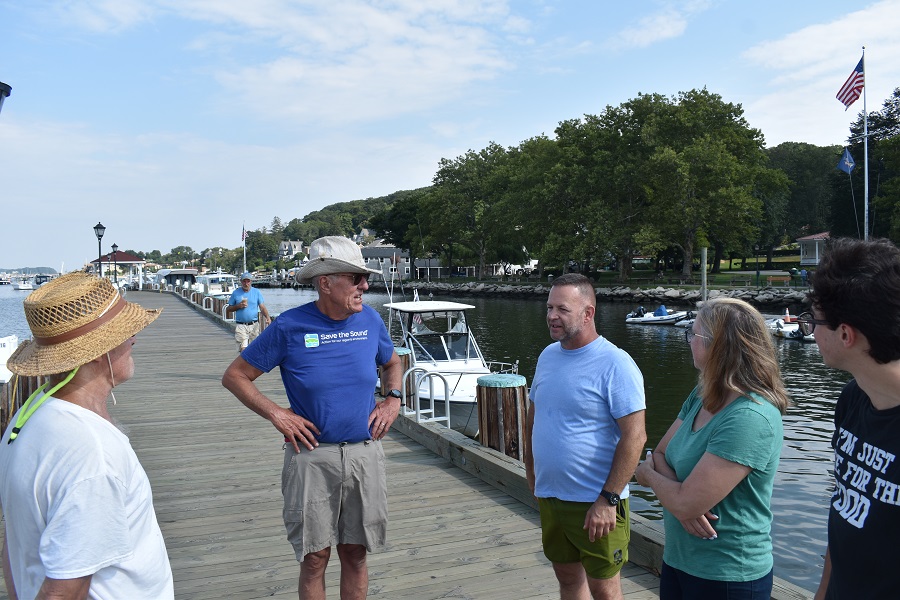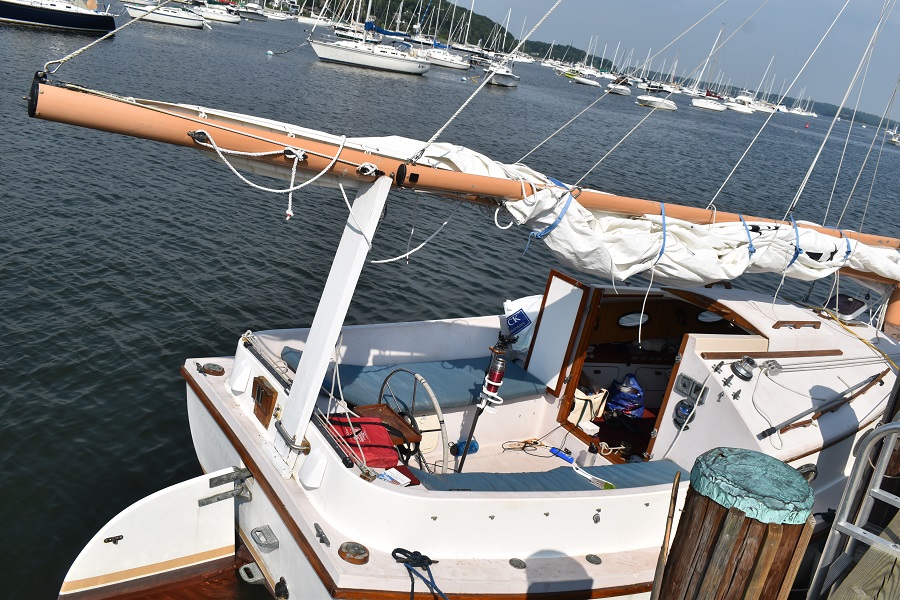We’ve come a long way, but a “slow emergency” still threatens Long Island Sound

Curt Johnson has lived near Long Island Sound for most of his life, but sailing this magnificent waterway still has the power to evoke awe, inspire action, and teach him—and all of us—about being better stewards of its precious waters. Curt recently made a five-day circuit of the Sound’s shores by sailboat with neighbor and friend Jamie Flynn to see for himself how this waterway that he’s spent his life defending is doing this summer, in the 50th anniversary year of both the Clean Water Act and Save the Sound.
Curt’s journey took him from his home on the Farm River in Branford, CT, to Port Jefferson and Northport, NY on the north shore of Long Island, then back to the CT cities of Bridgeport and Milford before sailing home. Along the way, Curt talked with dozens of people who connect with the Sound as residents, business owners, stewards, and visitors.
Northport Harbor is a good example of how the Sound has changed since the passage of the Clean Water Act made it possible for citizen groups to hold municipalities accountable for keeping our water safe. Before Northport’s sewage treatment plant was upgraded, the amount of nitrogen in the harbor was overwhelming it, causing regular brown tides of toxic algae blooms. Shellfish beds were closed. It wasn’t safe for people or their pets to play in the water. Since the plant’s upgrade, Curt said, the amount of nitrogen has been cut by more than two-thirds. “The upgrade is starving brown tides from the nitrogen that fuels their destruction. That’s just a great example of some of the progress that we are making,” he said. A conversation with lifetime Northport residents he met at the town dock confirmed their appreciation of a cleaner harbor.
Northport isn’t alone in its progress. “The collective work of so many people to upgrade sewage treatment plants”—more than 140 Soundwide—“has made a tremendous difference in terms of the water quality as compared to when I was a kid,” Curt said. Save the Sound has played a crucial role in that effort. Our Soundkeeper patrols the waters looking for and responding to reports of pollution. Our water quality lab conducts frequent testing for bacteria to determine the safety of beaches and other recreational areas. And our legal team has filed dozens of Clean Water Act lawsuits against polluting municipalities and collaborated with many more to meet their obligations without court action.
At the same time, challenges remain. After spending a night in Northport Harbor, Curt noted it “remains very green, an indication of a lot of chlorophyll.” He was also struck by the sheer volume of recreational traffic in both Northport and Milford. Northport residents told Curt they remembered 60 to 80 boats anchored in the harbor in their childhood. Today, he estimated, there are several hundred, “just a huge flotilla.” “On the one hand, it’s great to have so many more people enjoying getting out on the water,” Curt said. On the other hand, he woke up in the harbor to the smell of diesel fuel, which he reported to the local marine patrol.
“One thing I was struck by on this trip was how many communities you see along the coast that are exposed to Long Island Sound,” Curt said. “With increasing sea level rise and bigger storms, they’re incredibly vulnerable…”
Curt’s journey also took him past Save the Sound’s coastal restoration project at the hugely popular Sunken Meadow State Park, where 18 acres of pavement have been replaced with green infrastructure to reduce stormwater runoff polluting a nearby creek and Long Island Sound, and invasive Phragmites reeds have been replaced with native marshes and shrubs. “One thing I was struck by on this trip was how many communities you see along the coast that are exposed to Long Island Sound,” Curt said. “With increasing sea level rise and bigger storms, they’re incredibly vulnerable. There are just so many areas where you can tell the tidal marsh is eroding, and if we don’t start doing the kinds of projects that we have done in Sunken Meadow and really expand that work with many of our partners, in just a few decades we run the risk of losing our tidal marsh system. That would leave our communities exposed to wave damage and erosion and have a huge negative effect on the ecological richness of the Sound. This is a slow-moving emergency that we really need to pay attention to.” Save the Sound is currently working on ecological restoration projects in Guilford, CT and Little Neck Bay in NY, part of a larger strategic plan that calls for supercharging the pace and scale of river and coastal restoration in dozens of cities and towns throughout the Long Island Sound region.

Over the course of his journey, Curt’s conversations with the people he met touched on the use of solar power to electrify dock boats and ferries, green infrastructure, homeowners’ overuse of garden fertilizers, and the socioeconomic shift in Long Island’s small towns from working class to exclusive, among other topics—not to mention dozens of questions about the traditional 23-foot, Long Island-built Menger Cat boat on which he was sailing.
Among the people Curt met were two of Save the Sound’s partners in the Unified Water Study, working via Cornell Cooperative Extension. They were just back from collecting water samples off the shore of Long Island, a task that must be undertaken early in the morning, when oxygen levels are at their lowest. With a planned expansion of Save the Sound’s Soundkeeper program to Long Island’s north shore, water quality there will get much needed attention. “There is still too much nuisance algae, too much murky water, and too little oxygen in a lot of these bays and harbors, so we’re already on the verge of fish kills there,” Curt said. The borough of Queens experienced a major fish kill this summer. “I am seeing the effectiveness of our Soundkeeper, water quality team, and legal teams really making an impact in cutting down that pollution.”
By the end of five days, Curt’s trip had energized his work by reminding him of just how many people care about Long Island Sound. “There’s a huge number of people who don’t live on the Sound, can’t afford to live there, but have built a love of the Sound through a special park, a beach, a dock, or a boat. Their connection to the Sound is really powerful. Because its waters are relatively protected, it’s a place where people bring their kids to learn how to swim, it’s a place where it’s easy to take a kayak out, and it’s a very people-friendly place to recreate. It’s inspiring to see how many people love this resource that we’re working to protect.”
Curt joined Save the Sound—then Connecticut Fund for the Environment—in 1993 to lead its legal team. Over the decades since, he has served multiple leadership roles overseeing programs and helped make possible the mergers of Save the Sound, Connecticut Fund for the Environment, and Soundkeeper, Inc. before becoming president of the combined regional organization in 2017. He will retire as president on October 1, handing the helm to current vice president of programs Leah Lopez Schmalz, who has been with the organization for 20 years. Read more on our leadership transition here.
